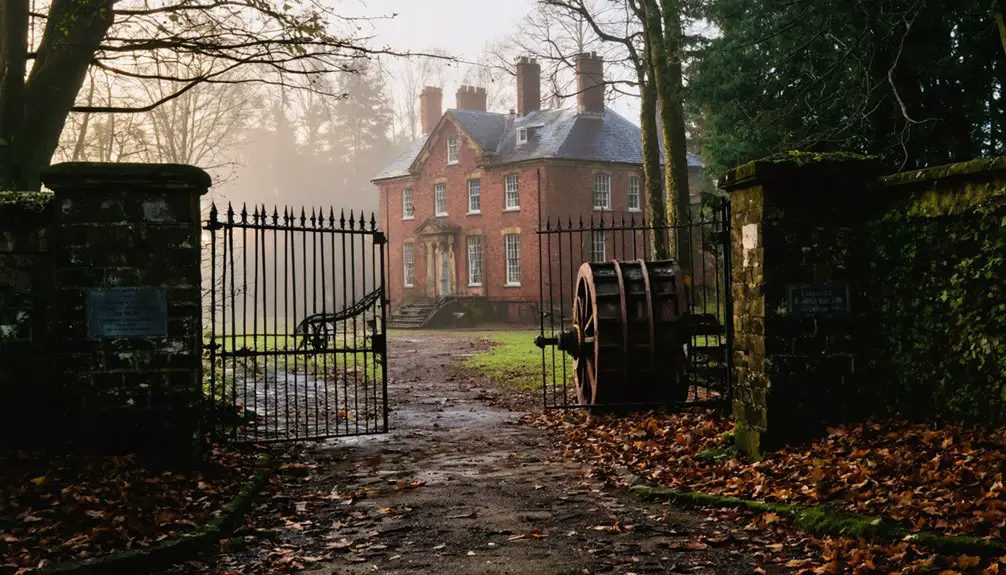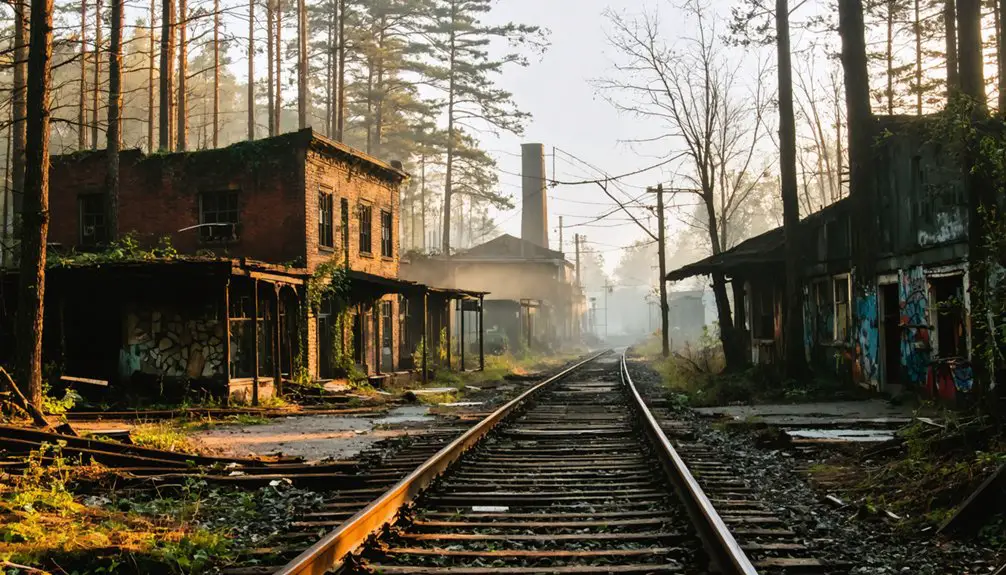You’ll find Whitesbog Village, a historic ghost town in New Jersey’s Pine Barrens, where the world’s first cultivated blueberries emerged in 1916. Originally established in 1857 as a cranberry farm by James Fenwick, it grew into a thriving company town of 600 workers under J.J. White’s leadership. By mid-20th century, agricultural mechanization emptied the village, but today’s preserved buildings, including Elizabeth White’s home-turned-visitor-center, tell fascinating stories of this agricultural pioneer community.
Key Takeaways
- Whitesbog Village transformed from New Jersey’s largest cranberry farm into a ghost town due to agricultural mechanization.
- The once-thriving company town housed 600 workers during harvest seasons but declined to just a few residents by mid-century.
- Abandoned processing facilities and worker housing remain as physical evidence of the village’s former prosperity.
- In 1967, the J.J. White Company sold the ghost town to New Jersey, leading to its preservation as a historic site.
- The Whitesbog Preservation Trust now maintains the ghost town’s original buildings and offers cultural heritage activities.
From Natural Cranberry Meadow to Agricultural Empire
While natural cranberry meadows dotted the landscape of mid-1800s New Jersey, Whitesbog’s transformation into an agricultural powerhouse began in 1857 when James A. Fenwick purchased 108 acres of former Hanover Furnace land. His pioneering cranberry cultivation techniques turned the wild meadows into a thriving commercial operation. Fenwick recognized the land’s exceptional cranberry production potential and began development immediately.
After Fenwick’s death in 1882, J.J. White took control and revolutionized the farm through bold agricultural innovations. Under his leadership, you’d have witnessed the operation expand to over 3,000 acres of cranberry bogs by the early 1900s.
The site evolved into a bustling company town with modern packaging facilities, storage buildings, and distinctive sugar sand roads. White’s vision transformed Whitesbog into New Jersey’s largest cranberry farm, creating an agricultural empire that perfectly balanced industrial-scale farming with the region’s natural Pine Barrens ecology. His daughter Elizabeth later achieved fame by developing the first cultivated blueberry in 1916.
The Legacy of Elizabeth White’s Blueberry Innovation
Before Elizabeth Coleman White revolutionized the blueberry industry in 1916, many believed wild blueberries couldn’t be commercially cultivated due to their inconsistent size and sweetness. She partnered with USDA botanist Frederick Coville, paying local woodsmen to find wild bushes with berries larger than 5/8 inch. Of 120 bushes discovered, only two met their standards for blueberry cultivation. Through extensive cross-fertilization techniques, they successfully enhanced and standardized blueberry production.
White’s agricultural innovation transformed New Jersey into a blueberry powerhouse. She founded the New Jersey Blueberry Cooperative Association in 1927, pioneered cellophane packaging for shipping, and built a $40 million industry. Her dedication to innovation earned her the nickname “The Blueberry Queen” for her groundbreaking contributions to agriculture.
Her family farm produced 20,000 barrels annually, contributing to South Jersey’s 21% share of global production. As the first woman recognized by the state’s Department of Agriculture, White’s legacy lives on in Whitesbog Village and New Jersey’s thriving blueberry farms.
Life in a Self-Sustaining Company Town
Since its founding in the 1850s as a cranberry farming enterprise, Whitesbog Village embodied the classic American company town model under J.J. White’s leadership.
You’d find all aspects of communal living controlled by the company – from the general store and post office to worker housing and the schoolhouse.
Life revolved around seasonal labor, with the village’s population swelling to 600 workers during harvest times. You’d see Italian immigrants from Philadelphia joining the permanent residents, staying in separate housing while picking cranberries and blueberries.
The company maintained strict oversight of daily life, providing essential services through the water tower and packing facilities. After Elizabeth White’s successful highbush blueberry cultivation in 1916, the village expanded its agricultural operations significantly.
The general store served as both a commercial hub and social center, where workers gathered and shopped, creating a tight-knit community bound by their shared agricultural purpose.
The Slow Transformation Into a Ghost Town
The advent of agricultural mechanization in the 20th century marked the beginning of Whitesbog Village’s transformation into a ghost town. As harvesting technology improved, the need for seasonal workers, particularly Italian immigrants, dramatically decreased.
The technological impact rippled through the community, causing the once-bustling village to shrink from hundreds of workers to just a handful by mid-century. James Fenwick’s cranberry cultivation in 1857 had established the foundation for what would become this thriving agricultural center.
You’ll find evidence of this community decline in the abandoned processing facilities and worker housing that dot the landscape today. When the J.J. White Company sold the village to New Jersey in 1967, it sealed Whitesbog’s fate.
The transformation from thriving company town to historic site was complete by 1982, when the Whitesbog Preservation Trust took over. While some buildings remain partially maintained for visitors, most stand as silent witnesses to a vanished way of life. Today, the first commercial blueberries were developed here serves as a reminder of Whitesbog’s agricultural innovation and historical significance.
Preserving History in the Pine Barrens Today
Modern preservation efforts at Whitesbog Village have transformed this historic site into an engaging cultural heritage destination through strategic funding and community support. Since 1990, over $690,000 in preservation grants have funded essential restorations, including a major 2004 project that revitalized 22 historic structures.
You’ll find the Whitesbog Preservation Trust at the heart of historical preservation efforts since 1977. They’ve turned Elizabeth White’s home into a visitor center and maintain over 20 original buildings. The village’s legacy includes its role as the birthplace of cultivated blueberries. Located in Brendan T. Byrne Forest, the historic village welcomes visitors daily from sunrise to sunset.
Through their work, you can experience everything from cranberry harvest tastings to haunted tours. The Trust’s latest initiative, a storytelling app called “Deep in the Pines,” brings the village’s rich history to life.
Community engagement thrives through festivals, farm dinners, and volunteer opportunities that keep this Pine Barrens treasure alive.
Frequently Asked Questions
Are There Any Reported Ghost Sightings or Paranormal Activity at Whitesbog Village?
Like whispers in the dark, you’ll discover ghost stories about mysterious tracks, unexplained sounds, and shadowy figures near haunted locations throughout the village, though formal documentation remains limited at this historic site.
What Wildlife Species Can Visitors Commonly Encounter in Whitesbog Today?
You’ll experience remarkable wildlife diversity through bird watching – spotting eagles, owls, and waterfowl – while possibly encountering black bears, bobcats, white-tailed deer, and various amphibians in their natural habitat.
How Much Did Workers Typically Earn During Whitesbog’s Peak Operations?
You wouldn’t believe how little workers earned! With wage history showing just $0.50-$1.50 per day under tough labor conditions, they relied heavily on company housing and store credit to survive.
Can Visitors Pick Blueberries or Cranberries at Whitesbog in Modern Times?
You can enjoy blueberry picking during summer Saturday festivals in July, with a pint limit per person. However, you can’t pick cranberries – they’re only available through guided educational tours.
What Happens to Whitesbog Village During Severe Weather and Flooding Events?
Like an Instagram story gone viral, you’ll notice flooding impacts are managed through historic water control systems. During severe weather, the village’s infrastructure and preservation teams handle rising waters with practiced preparedness.
References
- https://whitesbog.org/history-about/
- https://rsftripreporter.net/gone-goner-ghost-towns-new-jersey-pine-barrens-part/
- https://bestofnj.com/features/entertainment/jersey-through-history-whitesbog-village/
- https://www.journeythroughjersey.com/sites/historic-whitesbog-village/
- https://www.nj.gov/dep/parksandforests/historic/whitesbogvillage.html
- https://www.nj.gov/dep/parksandforests/education/docs/sght-Whitesbog_11 x 17 version_2_27_24web.pdf
- https://visitsouthjersey.com/directory/whitesbog-village/
- https://www.njagsociety.org/news/the-beginning-of-blueberry-farming-the-story-of-whitesbog
- https://njbusinessadvocate.com/njchamber/events/wia/89-features/women-in-innovation/profiles/928-elizabeth-coleman-white
- https://www.usda.gov/about-usda/news/blog/woman-who-cultivated-billion-dollar-industry



